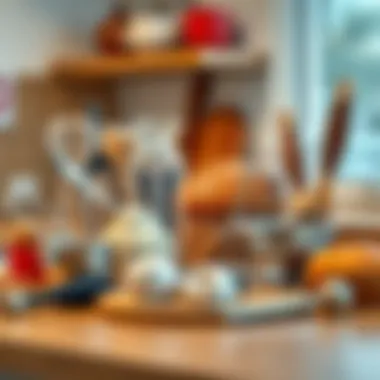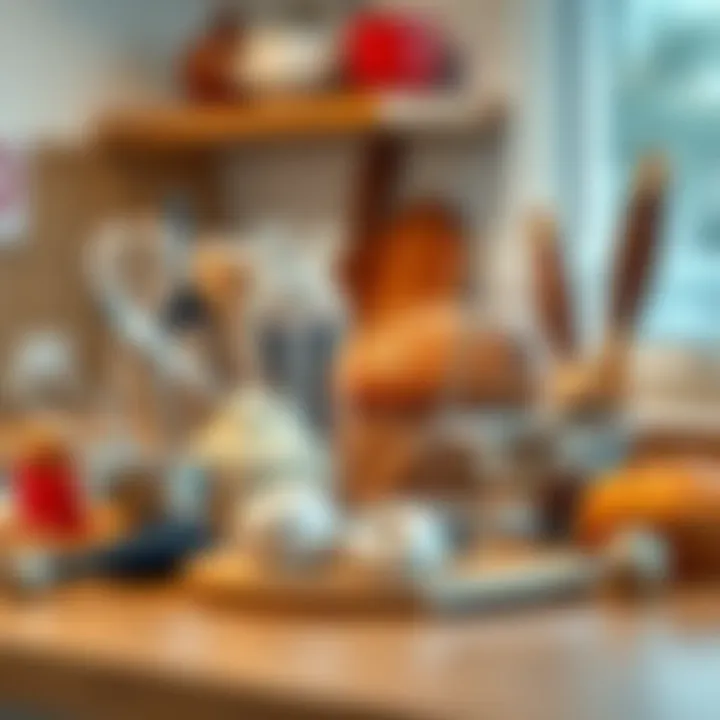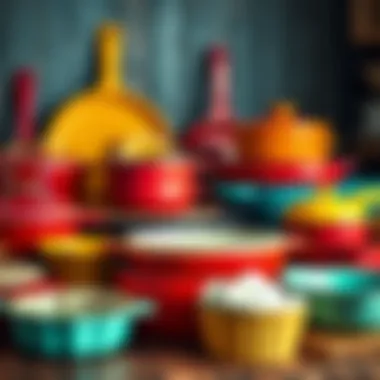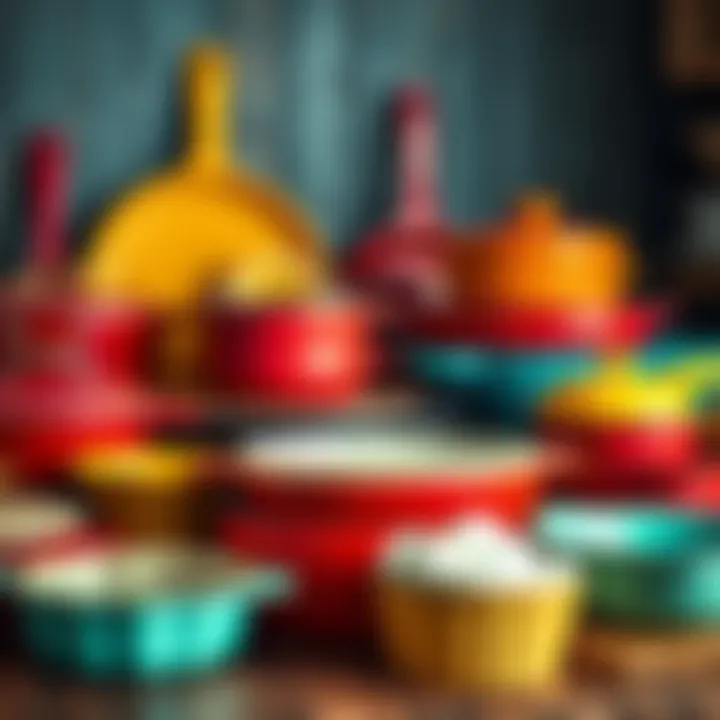Essential Baking Tools: A Comprehensive Guide


Intro
In the world of baking, the tools you choose can make or break your culinary creations. It's easy to think that any old kitchen gadget will do, but the right tools can drastically influence the quality of your baked goods. Understanding why each tool is vital not only enhances your baking experience but also builds your confidence in the kitchen.
Often, novice bakers feel overwhelmed with choices and may underestimate the significance of each item on the counter. From measuring cups to whisk attachments, every tool has its purpose, and knowing how to utilize them can elevate your baking game. This guide will walk you through the essential tools, discussing their functionalities and how they contribute to your baking success.
This comprehensive overview is not just for the hobbyists who dream of being the next pastry chef; it’s invaluable for seasoned bakers looking for specific insights. You’ll uncover how each tool works and why it deserves a place in your kitchen drawer.
Baking doesn't just happen. It requires precision, skill, and—most importantly—appropriate tools. As you continue reading, think about the tools you already have at your disposal. Do they measure up? Are they contributing to your baking prowess or holding you back? Let’s dive deeper into the must-have tools and how to make them work for you.
Prolusion to Baking Tools
In the world of baking, tools are more than just utensils; they are an extension of your creativity and precision. Understanding the essentials of baking tools can transform an ordinary baking session into a masterpiece. The right tools not only enhance your efficiency but also improve the quality of your baked goods.
The Importance of Choosing the Right Tools
Choosing the right baking tools is akin to selecting the right brush for an artist. Each tool serves a specific purpose that can affect the outcome of your baking. For instance, using a high-quality whisk can incorporate air more effectively into a batter than a flimsy one, leading to fluffier results.
- Precision Matters: Precision tools such as digital scales ensure that ingredients are measured accurately. This is crucial because baking is a science where proportions matter.
- Durability: Investing in durable tools means they can withstand the rigors of frequent use. A good mixing bowl or a sturdy spatula can last years, saving you money in the long run.
- Adaptability: Some tools serve multiple functions, which is important for those with limited kitchen space. A well-rounded kitchen might include tools that can transition from baking cookies to making bread with just a quick change in technique.
Ultimately, understanding what each tool does and how to use it effectively can elevate your baking from a chaotic process to a well-oiled machine.
Baking vs. Cooking: Tool Distinctions
Baking and cooking may seem similar, but they require distinct approaches, especially when it comes to tools. Baking is often viewed as a precise science, while cooking allows for more energy and spontaneity. Here’s how the tools diverge:
- Measuring Tools:
- Mixing Techniques:
- Specialty Bakeware:
- Baked goods thrive on exact measurements. While cooking often allows for a pinch of this or that, precise measuring cups and scales are non-negotiable in baking.
- A stand mixer can be a game-changer in baking. Unlike cooking, where a simple wooden spoon may suffice, a stand mixer provides that controlled and consistent beating needed for dough development.
- Baking often utilizes specialty pans like tart pans or springform pans that aren’t typically found in cooking. A sturdy oven-safe dish is far more critical in baking than in general cooking, where versatility is more common.
In sum, while both baking and cooking share a common goal—creating delicious food—mastering the tools of baking specifically can set you on the path to sweet success. Whether one is a novice or seasoned baker, recognizing these distinctions is essential for mastering the art of baking.
Measuring Tools and Their Uses
In the world of baking, every ingredient counts and the precision of measurements can make or break a recipe. Choosing the right measuring tools is paramount for achieving consistency and excellence in your baking. By understanding how to effectively use these tools, bakers can replicate their successes and avoid culinary catastrophes. Here, we delve into various measuring tools, enhancing your baking experience and ensuring your creations are delightful.
Digital Scales for Precision
When it comes to ingredients, baking is a science. A digital scale serves as an indispensable tool in this scientific pursuit. Unlike cups and spoons which can lead to variable results based on how ingredients are scooped or packed, a digital scale provides accurate measurements in grams and ounces. This is particularly crucial for ingredients such as flour, where even slight deviations can alter texture and taste.
Using a digital scale is straightforward; just place your bowl on the scale, zero it out, and add your ingredients. This method allows for hassle-free measurement of multiple components without the need for extra bowls. Moreover, scales enable bakers to experiment with ingredient substitutions more confidently, knowing they have the exact measurements required.
"The accuracy of a digital scale translates directly into better baking results, making it a worthy investment in any baking arsenal."
Measuring Cups: Dry vs. Liquid
Measuring cups are fundamental tools in baking, but it's essential to distinguish between those designed for dry ingredients and those intended for liquids.
- Dry Measuring Cups: These cups typically have a flat top, allowing you to level off ingredients for the most accurate measurement. They are ideal for flour, sugar, and similar substances. Using a dry measuring cup, you would scoop flour and then use a straight edge, like a knife, to remove excess. This helps ensure you aren't over or under-measuring, which can affect the final product.
- Liquid Measuring Cups: Designed with spouts and often made from glass or plastic, these cups feature markings on the side allowing you to measure various volumes accurately. When measuring liquids, it’s important to check the measurement at eye level to avoid parallax error, which can lead to discrepancies in amount.
Engaging with both types of cups correctly allows for precise measurements that are critical in baking recipes that call for accuracy.
Measuring Spoons: Essentials for Accuracy


Measuring spoons, though small, pack a punch regarding importance in the baking process. These tools aren’t just for spooning out spices or baking powder; they are crucial for ensuring each ingredient aligns with the recipe's specifications.
A standard set of measuring spoons typically includes 1 tablespoon, 1 teaspoon, half teaspoon, and a quarter teaspoon. Each spoon should be filled to the brim and leveled off for the best results. Here are a few insights into their use:
- Hierarchy of Sizing: When measuring ingredients like baking soda or salt, remember that even a tiny excess can lead to an undesired taste profile in your final baked goods. A proper use of measuring spoons can prevent this.
- Conversion Help: For those who prefer to work with metric measurements, understanding the conversions—for example, one tablespoon equals approximately 15 milliliters—can enhance precision when recipes come from various sources.
By honing your skills with these measuring tools, you will undoubtedly become a more proficient baker, capable of conquering complex recipes with finesse.
Mixing Tools: Key Components of Baking
In the art of baking, mixing is where the magic begins. Selecting the right mixing tools can greatly shape the textures and flavors of your baked goods. From creating fluffy cake batters to mixing dense doughs, each tool serves a unique purpose with specific benefits. Understanding mixing tools not only enhances your efficiency but also helps you find success in achieving desired results when baking.
Hand Mixers vs. Stand Mixers
When it comes to mixing, one of the first decisions a baker faces is choosing between hand mixers and stand mixers. Each has its perks, making them suitable for different baking scenarios.
Hand Mixers are compact and portable, perfect for quick tasks or smaller batches. They’re easy to store and handle, allowing for a more hands-on approach. For instance, if you're whipping up a small batch of frosting, a handheld mixer can be a swift and convenient choice.
On the flip side, Stand Mixers offer power and versatility. They come equipped with various attachments suited for a plethora of tasks, from kneading dough to whipping cream. When tackling larger quantities, such as preparing bread dough for family gatherings, stand mixers can help to save time and energy. The stand mixer holds the bowl in place, freeing up your hands to add ingredients or adjust settings.
Ultimately, the choice hinges on personal preference and the kind of baking you often do. A serious baker might find both tools essential in their kitchen arsenal.
Whisks: Varieties and Their Applications
Whisks come in many shapes and sizes, each designed to tackle specific mixing tasks. A few common types include:
- Balloon Whisks: These are wider and feature more wires, making them ideal for whipping air into mixtures like eggs or cream.
- Flat Whisks: These are excellent for mixing thinner batters or sauces, as their shape allows for effective incorporation with minimal splatter.
- Dough Whisks: With a unique design, these are perfect for mixing heavy bread dough without overworking it.
Understanding which whisk to use can elevate your mixing game dramatically. For example, using a balloon whisk for a heavy batter can lead to a strenuous mixing ordeal, while a dough whisk handles thick mixtures with ease.
Spatulas: Silicone, Wood, and Metal
Spatulas may seem like simple tools, but they can significantly impact the outcome of your baking. Each material has distinct advantages:
- Silicone Spatulas: These are heat resistant and perfect for scraping batter from bowls without leaving remnants behind. Their flexibility allows you to get every last bit out of the mixing bowl, minimizing waste.
- Wooden Spatulas: Sturdy and durable, they excel at mixing thick doughs. However, they are not ideal for non-stick cookware as they can scratch the surface.
- Metal Spatulas: These are often used for flipping baked goods or cookies. They provide strength for lifting and can also stand up to higher temperatures.
Choosing the right spatula for the job can make mixing and transferring easier, and it also helps in achieving a polished end product.
"Understanding the tools of baking is as important as the ingredients themselves. The right tool can turn an average cookie into an extraordinary one."
Bakeware Essentials
In the bustling world of baking, the equipment you choose becomes a silent yet crucial partner in your culinary journey. Having the right baking tools at your fingertips can make the difference between a glorious success and a complete flop. Bakeware essentials encompass the variety of pans and molds that not only shape your creations but also function to achieve specific baking results for different recipes. Every baker, whether novice or experienced, needs to understand the nuances of these tools and how they affect outcomes.
Types of Baking Pans
Sheet Pans
Sheet pans are like the workhorses of baking. They are flat trays usually made of metal, designed to hold a variety of baked goods—from cookies to roasted vegetables. Their key characteristic lies in the wide, flat surface area which enables even heat distribution. Because of this, they tend to be a beneficial choice for bakers who want a reliable tool suitable for multiple tasks. The unique feature of sheet pans is their ability to handle a significant amount of batter or dough, but they do have their disadvantages. If used without a proper lining, baked items can stick, causing frustration when retrieving your treats.
Cake Pans
When it comes to whipping up layers of delight, cake pans are a baker's best ally. Typically round or square, these pans are specially shaped to help create the perfect structure for cakes. The key characteristic of cake pans is their depth; this allows for a satisfying rise during the baking process. They are widely regarded as essential for anyone looking to master cake-making. A unique feature is the ability to buy them in graduated sizes, perfect for creating layered cakes. One disadvantage worth noting is that some cake pans may require greasing and flouring, which can be a small hassle, but the payoff is a beautifully baked cake.
Muffin Tins
Muffin tins are indispensable for those who revel in the world of muffins, cupcakes, or even savory treats like quiches. Their key characteristic is the individual cup shapes that ensure optimal baking conditions for each portion. This specialized design makes them a popular choice for busy bakers who want to whip up several items at once. The unique feature of muffin tins is their ability to guide batter towards rising evenly, leading to perfectly dome-shaped muffins. However, one downside is that cleaning can be a bear if they're not non-stick, requiring a little more effort to keep them tidy after use.


Choosing the Right Material
Baking pans come in a variety of materials, each with its own set of benefits and drawbacks. Knowing which material fits your baking style is critical.
Metal
Metal pans, often aluminum or steel, are favored for their excellent heat conductivity. This means that your batters will rise evenly, leading to successful bakes. A key characteristic is their durability—metal pans can handle significant wear and tear. They are a beneficial choice for those who bake frequently since they tend to be lightweight and easy to manage. However, a notable disadvantage is that they can warp if subjected to extreme temperature changes, which can affect your baking results.
Glass
Glass bakeware offers the unique advantage of being able to see through to your baked goods as they cook. A key characteristic is that glass heats evenly, so it’s less likely to result in hot spots. This makes glass a popular choice for recipes requiring careful control, such as custards or delicate cakes. However, glass can be quite fragile, contributing to a disadvantage in kitchens with unsteady hands and clumsy moments.
Silicone
Silicone baking pans have gained popularity due to their flexibility and versatility. The key characteristic lies in their non-stick nature, which means you can bake without worries about your goods sticking. Silicone is a beneficial choice if you hate scrubbing pans post-baking. The unique feature of silicone molds is their ability to be folded or squeezed, providing astonishing ease of storage. On the flip side, they can sometimes bake unevenly, as they don’t conduct heat as well as metal or glass, so it's important to be cautious when trying precise recipes.
Specialty Bakeware for Unique Recipes
Specialty bakeware comes into play when a recipe calls for something specific that standard pans can’t provide. Owning a few specialized pans can truly expand your baking repertoire.
Springform Pans
These pans are a game-changer when it comes to delicate desserts like cheesecakes. A key characteristic of springform pans is their removable sides, allowing for easy unmolding of fragile cakes. This makes them a beneficial choice for anyone who wants presentation without the heartache of crumbling. The unique feature is the tight clamp system that prevents leaks during the baking process. However, one disadvantage is the potential for the pan to leak if not properly secured, so one must take care when preparing a springform.
Bread Loaf Pans
For those who delight in fresh-baked bread, loaf pans are essential. They are distinctly characterized by their elongated shape, which helps create the traditional loaf structure. A strong reason these pans are a popular choice among bakers is that they are perfect for achieving that bakery-style crust. The unique feature is the capacity to create even loaves without much fuss, but they can also be a bit cumbersome to store, taking up more space than other pans.
Tart Pans
Tart pans are specifically designed for creating gorgeous tarts. They typically have a removable bottom, which helps in presenting tarts without fuss. Their key characteristic is the fluted edges, which make tart crusts both beautiful and easy to slice. They are a beneficial choice for dessert aficionados aiming to impress. However, the unique feature also serves as a disadvantage; the thin metal can lead to quick over-baking if not monitored closely, so one must keep an eye on the clock.
In summary, understanding the intricacies of baking pans, materials, and specialty bakeware can empower bakers of all levels. With the right bakeware essentials in place, you are more than equipped to tackle any recipe that comes your way.
Ovens and Temperature Control
Baking is an art, and like any artist, having the right tools can make a world of difference. Ovens stand at the heart of this art form, serving as the primary catalyst for transforming raw ingredients into delectable baked goods. Understanding ovens and their temperature control mechanisms is vital for achieving that perfect texture and flavor in your creations.
Understanding Oven Types
When it comes to baking, not all ovens are created equal. Each type offers distinct advantages and disadvantages suited for various baking needs. Let’s take a closer look at the most common ovens you'll encounter in the kitchen.
Conventional Ovens
Conventional ovens are often the bread and butter of home kitchens. They operate using radiant heat, primarily from heating elements located at the top and bottom. The characteristic of these ovens is their straightforward operation. With a conventional oven, you can confidently bake cakes, breads, and roasts with predictable results.
One key advantage of conventional ovens is their wide availability and relatively modest price point. They can bake evenly if you position your pans correctly, usually in the middle of the oven. However, if you don’t rotate your pans during baking, you might end up with uneven results. These ovens can be great for bakers who prefer simplicity over complexity.
"Conventional ovens might be basic, but their reliability makes them a favorite among many home bakers."
Convection Ovens
On the other hand, convection ovens are a step up from their conventional counterparts. They have a built-in fan that circulates the hot air, ensuring an even cooking temperature around the food, leading to faster and more consistent baking. This characteristic makes them a popular choice for those looking to produce professional-quality baked goods at home.
One of the unique features of convection ovens is their ability to cook multiple trays at once without the worry of hotspots. However, they may require some adjustment in baking temperatures and times, as foods can cook quicker than in conventional ovens. This means that bakers need to pay closer attention and may need to reduce the temperature by about 25 degrees Fahrenheit.
Microwave Ovens


Though not traditionally used for baking, microwave ovens play an essential role in many kitchens. They use electromagnetic waves to excite water molecules in food, heating them from the inside out. This method allows for quick cooking, which can be beneficial in a pinch.
The microwave can be particularly handy for melting ingredients like butter or chocolate, but it’s less ideal for achieving the crispy texture usually desired in baked goods. Oftentimes, bakers opt for microwave-specific recipes that ensure the results don't fall flat. They’re great for reheating but require a different mindset when it comes to baking.
Utilizing Thermometers for Accuracy
When it comes to baking, precision is not just recommended—it’s essential. Utilizing thermometers, like the instant-read or probe options, can significantly enhance your baking outcomes. Whether it’s ensuring your oven temperature is accurate before you start baking or checking the doneness of your bread, having this tool on hand will help you achieve the desired results consistently.
Cooling Tools: The Final Touch
In the baking process, cooling tools might not enjoy the limelight quite like measuring cups or fancy mixers do. However, they perform an invaluable function that often gets overshadowed—proper cooling can mean the difference between a delightful, moist cake and a soggy mess. With that, the right cooling tools allow baked goods to maintain their texture and flavor, rather than turning into a disaster due to excess moisture.
Wire Racks: Their Role in Baking
Wire racks are a baker's best friend when it comes to cooling. Their design, with elevated surfaces, promotes airflow, permitting steam to escape from the bottom of baked goods, keeping them from becoming soggy.
Benefits of using wire racks:
- Quick cooling: The open design allows cakes, cookies, and pastries to cool evenly and quickly.
- Prevents condensation: By allowing moisture to escape, baked goods remain light and fluffy.
- Versatility: Wire racks can also be used for other tasks, like drying herbs or cooling down just-baked pizzas.
These racks come in various sizes, making them incredibly adaptable for different baking projects. A larger rack can accommodate big sheet cakes, while a smaller one might be just perfect for cookies or muffins.
Cooling Trays: Considerations for Use
Cooling trays, similar to wire racks, serve a fundamental role in managing excess heat. Unlike wire racks, cooling trays often include a sturdy, flat surface that may provide additional features like raised edges to catch crumbs or drips.
When to use cooling trays:
- For delicate pastries: Use trays with raised edges to handle products that might crumble or tip over easily, like éclairs or cream puffs.
- For convenience: If you are tight on space, select a multi-tier cooling tray, which can help maximize your available counter area.
- For presentation: A well-designed cooling tray can double as a serving platter, allowing your creations to shine as they cool.
Overall, using the right cooling tools can greatly enhance your baking experience, ensuring that each loaf and layer comes out just as you envisioned. Remember, taking a moment to cool down your baked goods isn’t just a step in the process; it's an essential part of crafting delightful treats that will impress family and friends alike.
Storage Solutions for Baking Tools
Effective storage solutions for baking tools are crucial for maintaining an efficient and enjoyable baking experience. When the kitchen is organized, bakers can find their tools quickly, reducing the chaos that can accompany a baking project. Think of the time saved when reaching for that elusive measuring cup or spatula is as easy as pie.
Organizing Your Baking Tools
Keeping your tools organized isn’t just about aesthetics; it’s about creating a workflow that saves time and minimizes mishaps. One of the best ways to organize baking tools is by categorizing them. For example, grouping measuring tools, mixing implements, and bakeware can streamline the baking process significantly.
Here are some strategies for organizing baking tools effectively:
- Utilize Drawer Dividers: These can help separate utensils like whisks, spoons, and spatulas, making it easy to find exactly what's needed. By creating compartments, it can also prevent the tools from tangling together, which keeps everything easily accessible.
- Wall-Mounted Racks: For those short on space, a wall-mounted rack can double as a decorative element while providing easy access to frequently used tools. Hang your most favored spatulas or measuring cups right where you can see them. This approach not only saves space but also serves as a reminder of what's at hand.
- Pegboards: A pegboard allows for customizable tool storage. You can hang various baking tools at eye level, keeping them within reach when the dough is flying. Plus, it adds a bit of charm to your kitchen.
Culmination: Building Your Baking Arsenal
As you gather your baking tools, it’s crucial to recognize the significance of a well-chosen arsenal. Each baking tool is more than just an object; it’s a partner in your culinary journey. The right tools not only enhance efficiency but also elevate the overall experience. When building your baking arsenal, understanding your own needs and preferences ensures that you’re equipped for various baking endeavors, from the simplest cookie to the most intricate pastry.
Evaluating Your Needs
Before diving into the marketplace and splurging on every shiny gadget, take a step back and consider what you actually need. Ask yourself:
- What type of baking do I enjoy?
- Do I often bake in large quantities or just for a small gathering?
- Are there specific techniques or recipes I want to explore?
Answering these questions can provide a clearer picture. If you know you'll predominantly make pizza and bread, investing in a high-quality pizza stone and a sturdy loaf pan is a smart choice. Conversely, if you’re drawn to delicate cakes and pastries, investing in precision measuring tools and specialty pans becomes essential. It's all about focusing on what suits your baking style, rather than accumulating tools you might not use.
Investing Strategically in Quality Tools
Quality trumps quantity, especially in baking. Investing in quality tools not only improves performance but also increases durability, meaning they’ll stand the test of time. Opt for brands known for their craftsmanship, like KitchenAid for mixers or Wilton for bakeware.
When you look at tools, here are some aspects to keep in mind:
- Material Matters: Stainless steel often lasts longer than plastic.
- Ergonomics: A tool that feels good in your hand can make a world of difference during marathon baking sessions.
- Multi-functionality: Choose tools that can serve more than one purpose. A good whisk can mix batter, whip cream, and even help with salad dressings.
"The best investment in the kitchen is buying quality over quantity. It can save you money in the long run, too."















